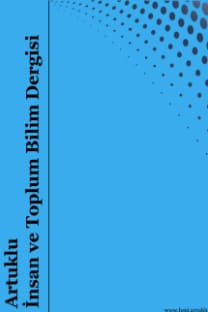Kişileştirme ve Didaktik Yaklaşım: "Gülün Romansı"
Tanrı’ya duyulan aşk ilk aşktır ancak gerçekte ilk aşk tensel aşktır ve bu yolla Doğa, türlerin devamını sağlamaya çalışmaktadır. Hristiyanlığın ana öğretisi olan aşk teması Ortaçağ şiirlerinde önemli bir yere sahiptir. Bu çalışmada "Gülün Romansı" eseri kişileştirme geleneği ve didaktik yaklaşım açısından incelenecektir. Eser 1230 ve 1280 yıllarında iki ayrı şair tarafından kaleme alınmış Avrupa saraylı edebiyatının en özgün ve en lirik eseridir. Guillaume de Lorris aşk sanatını anlatmak için şiirinde bir gül bahçesinin ortasındaki nadide bir gülle vücut bulan sevgilisine kavuşmaya çalışan kahramanın sonsuz aşkını düşsel bir anlatı çerçevesinde resmetmiştir. Jean de Meun 17723 dizelik eklenti ile şiire bir devam bölümü ve bir son eklemiştir. Söz konusu eserde Guillaume de Lorris, aşık olan kişiye görme, konuşma, dokunma ve öpme aşamalarını yaşatıp aşığın yakınmalarıyla eser sona ererken Jean de Meun ise tensel birleşme olan son aşamayı yaşatır. Dış biçimi itibariyle tamamen Ortaçağ’a özgüdür; aşk ile ilgili duyguların kişileştirilmesi en uç noktasına kadar götürülmüştür. Bu kişileştirmeler olmaksızın akıl, ruhun hareketlerini anlayamazdı ve bunlar bilimsel bir psikoloji terminolojisi gibi kullanılmaktaydı. Bu eserde aşk, teoride saraylı ve soylu olarak kalmıştır. Saraylı aşk aldatıcıdır çünkü bayan güç ve kontrole sahipken erkek itaat edendir. Ancak, gül elde edildiğinde oyun sona erecektir. Bu esere ruhunu veren şey, Jean de Meun’de kadının zayıflığının gaddarca küçümsenmesi olup bunun kökeni de bu aşkın tensel olma karakterinin içinde yer almaktadır.
Anahtar Kelimeler:
Saraylı Aşk, Kişileştirme, Guillaume de Lorris, Jean de Meun, "Gülün Romansı"
Personification and Didactic Approach: "The Romance of the Rose"
Love for God is the first love, but in reality first love is sensual love, and in this way Nature tries to maintain the continuation of the species. The theme of love, the main doctrine of Christianity, has an important place in medieval poems. This study examines "The Romance of the Rose" in terms of the personification tradition and didactic approach. It is the most original and lyrical work of European courtly literature written by two separate poets in 1230 and 1280. In order to explain the art of love, Guillaume de Lorris portrays in an imaginary narrative the eternal love of the hero who tries to reunite his lover embodied in a rare rose in the middle of a rose garden. Jean de Meun adds a continuation section and an ending to the poem with the addendum of 17723 lines. In the aforementioned work, while de Lorris gives the person in love the stages of seeing, speaking, touching and kissing, and the work ends with the complaints of the lover, de Meun gives the last stage of sensual intercourse. It is completely unique to Medieval Age in terms of its external form, and the personification of feelings and love situations has been taken to the extreme. Without these personifications, the mind would not be able to understand the movements of the soul, and they are used as a scientific psychology terminology. In this work, love remains, in theory, courtiers and nobles. Courtly love is deceptive because the woman has power and control while the man is obedient. However, once the rose has been acquired, the game will be over. What gives this work its soul is the brutal underestimation of women's weakness in de Meun, and its origin lies in this transcendental character of being sensual.
Keywords:
Courtly Love, Personification, Guillaume de Lorris, Jean de Meun, "The Romance of the Rose",
___
Capellanus, A. (1941). The Art of Courtly Love (J. J. Parry, Çev.). New York: Columbia UP.Cevizci, A. (2008). Ortaçağ Felsefesi Tarihi. Bursa: Asa Kitabevi.
Çevirici Çağın, A. (2006). Tevfik Fikret’in Şiirlerindeki Edebi Sanatlar. Yayımlanmamış Yüksek Lisans Tezi, İstanbul: İstanbul Üniversitesi Sosyal Bilimler Enstitüsü.
de Lorris, G. – J. de Meun (2008). The Romance of the Rose (F. Horgan, Çev.). Oxford: OUP.
Denomy, A. J. (1953). Courtly Love and Courtliness. Speculum, C. 28, S. 1, s. 44-63. Doi: 10.2307/2847180
Gilson, E. (2005). Ortaçağ Felsefesinin Ruhu (Ş. Öçal, Çev.). İstanbul: Açılım Kitap.
Gülcü, T. Z. (2015). Ortaçağ’da Hristiyan Felsefesi, Aşk Öğretisi ve Edebiyat: Gülün Romansı. Ankara Üniversitesi Dil ve Tarih-Coğrafya Fakültesi Dergisi, C. 55, S. 2, s. 271-286.
Hanscom, E. D. (1893). Allegory of de Lorris’ The Romance of the Rose. Modern Language Notes, C. 8, S. 5, s. 151-153. Doi:10.2307/2918597
Huizinga, J. (1997). Ortaçağın Günbatımı (M. A. Kılıçbay, Çev.). Ankara: İmge Kitabevi.
Moller, H. (1960). The Meaning of Courtly Love. The Journal of American Folklore, C. 73, S. 287, s. 39-52. Doi:10.2307/537601
Nouvet, C. (1991). Dangerous Resemblances: The Romance of the Rose. Yale French Studies, s. 196-209. Doi:10.2307/2929102
- Yayın Aralığı: Yılda 2 Sayı
- Başlangıç: 2016
- Yayıncı: Mardin Artuklu Üniversitesi
Sayıdaki Diğer Makaleler
Hamamda Cinayet: Orta Çağ’da Siyaseten Katlin Popüler Bir Mekânı Olarak Hamamlar
Uyur İdik Uyardılar, Alevîlik-Bektaşîlik Araştırmaları
Patolojik Narsisizm: Duygusal İstismar ve "Gaslighting" Perspektifinden Kapsamlı Bir Değerlendirme
Mardin Evlerinde Mihrabiye Formlu İki Niş
